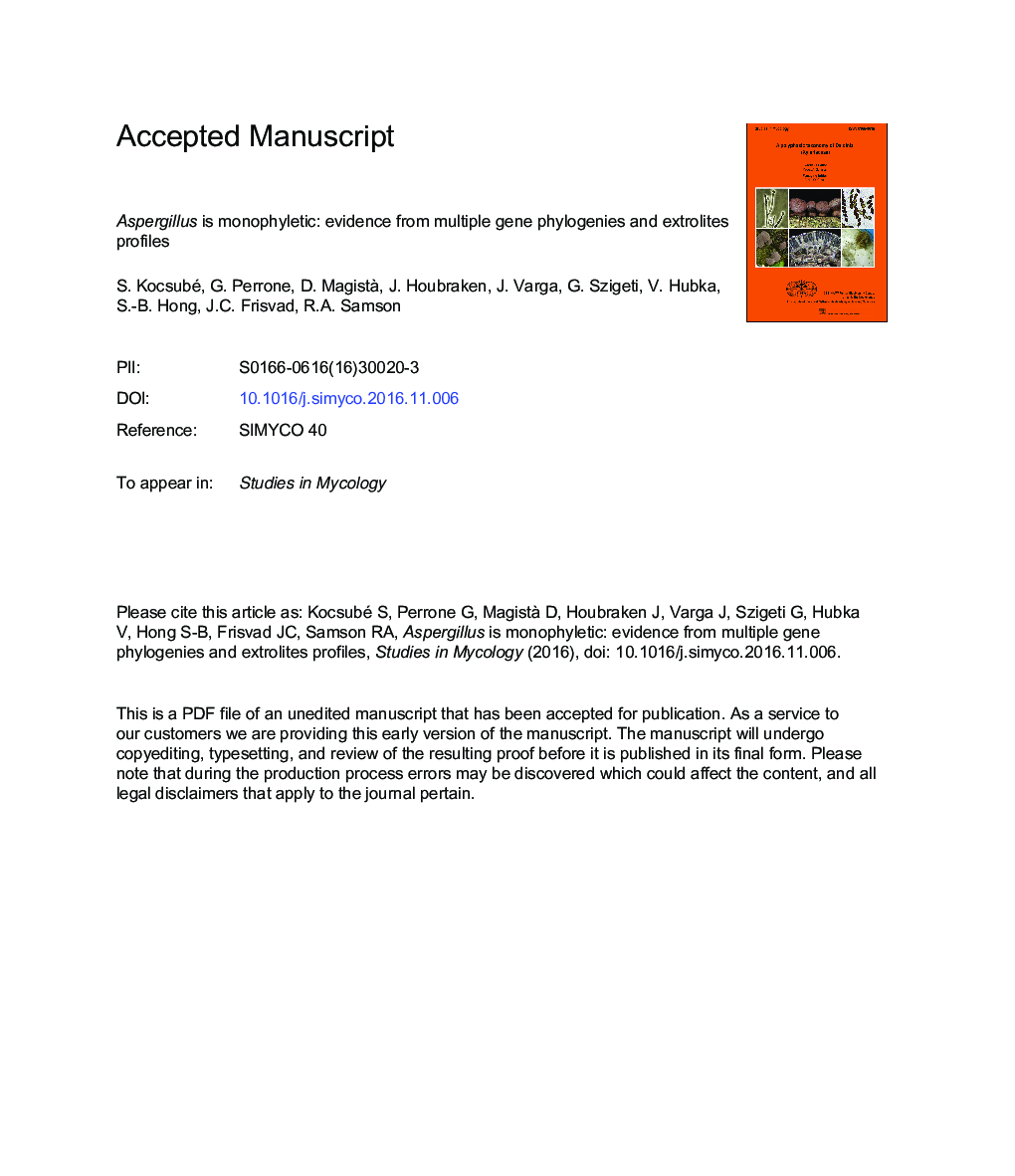| کد مقاله | کد نشریه | سال انتشار | مقاله انگلیسی | نسخه تمام متن |
|---|---|---|---|---|
| 6290469 | 1616935 | 2016 | 34 صفحه PDF | دانلود رایگان |
عنوان انگلیسی مقاله ISI
Aspergillus is monophyletic: Evidence from multiple gene phylogenies and extrolites profiles
ترجمه فارسی عنوان
آسپرژیلوس مونوفیلتیک است: شواهد از جنین های چندگانه و پروفایل های آزمایشگاهی
دانلود مقاله + سفارش ترجمه
دانلود مقاله ISI انگلیسی
رایگان برای ایرانیان
کلمات کلیدی
موضوعات مرتبط
علوم زیستی و بیوفناوری
علوم کشاورزی و بیولوژیک
بوم شناسی، تکامل، رفتار و سامانه شناسی
چکیده انگلیسی
Aspergillus is one of the economically most important fungal genera. Recently, the ICN adopted the single name nomenclature which has forced mycologists to choose one name for fungi (e.g. Aspergillus, Fusarium, Penicillium, etc.). Previously two proposals for the single name nomenclature in Aspergillus were presented: one attributes the name “Aspergillus” to clades comprising seven different teleomorphic names, by supporting the monophyly of this genus; the other proposes that Aspergillus is a non-monophyletic genus, by preserving the Aspergillus name only to species belonging to subgenus Circumdati and maintaining the sexual names in the other clades. The aim of our study was to test the monophyly of Aspergilli by two independent phylogenetic analyses using a multilocus phylogenetic approach. One test was run on the publicly available coding regions of six genes (RPB1, RPB2, Tsr1, Cct8, BenA, CaM), using 96 species of Penicillium, Aspergillus and related taxa. Bayesian (MrBayes) and Ultrafast Maximum Likelihood (IQ-Tree) and Rapid Maximum Likelihood (RaxML) analyses gave the same conclusion highly supporting the monophyly of Aspergillus. The other analyses were also performed by using publicly available data of the coding sequences of nine loci (18S rRNA, 5,8S rRNA, 28S rRNA (D1-D2), RPB1, RPB2, CaM, BenA, Tsr1, Cct8) of 204 different species. Both Bayesian (MrBayes) and Maximum Likelihood (RAxML) trees obtained by this second round of independent analyses strongly supported the monophyly of the genus Aspergillus. The stability test also confirmed the robustness of the results obtained. In conclusion, statistical analyses have rejected the hypothesis that the Aspergilli are non-monophyletic, and provided robust arguments that the genus is monophyletic and clearly separated from the monophyletic genus Penicillium. There is no phylogenetic evidence to split Aspergillus into several genera and the name Aspergillus can be used for all the species belonging to Aspergillus i.e. the clade comprising the subgenera Aspergillus, Circumdati, Fumigati, Nidulantes, section Cremei and certain species which were formerly part of the genera Phialosimplex and Polypaecilum. Section Cremei and the clade containing Polypaecilum and Phialosimplex are proposed as new subgenera of Aspergillus. The phylogenetic analysis also clearly shows that Aspergillus clavatoflavus and A. zonatus do not belong to the genus Aspergillus. Aspergillus clavatoflavus is therefore transferred to a new genus Aspergillago as Aspergillago clavatoflavus and A. zonatus was transferred to Penicilliopsis as P. zonata. The subgenera of Aspergillus share similar extrolite profiles indicating that the genus is one large genus from a chemotaxonomical point of view. Morphological and ecophysiological characteristics of the species also strongly indicate that Aspergillus is a polythetic class in phenotypic characters.
ناشر
Database: Elsevier - ScienceDirect (ساینس دایرکت)
Journal: Studies in Mycology - Volume 85, September 2016, Pages 199-213
Journal: Studies in Mycology - Volume 85, September 2016, Pages 199-213
نویسندگان
S. Kocsubé, G. Perrone, D. Magistà , J. Houbraken, J. Varga, G. Szigeti, V. Hubka, S.-B. Hong, J.C. Frisvad, R.A. Samson,
